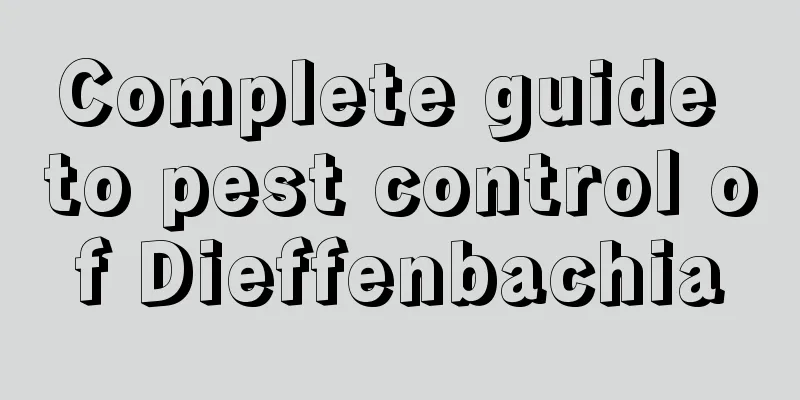Complete guide to pest control of Dieffenbachia

Leaf spotThis disease occurs on the leaves of evergreen and is more likely to occur in humid weather. The lesions are small brown spots at first, with the edges fading to green as if soaked in water, and then expanding in a ring-like pattern, circular to oval in shape, with brown edges and grayish white inside. In the later stage, dark brown mold spots appear in the center of the lesions, which turn into dark brown mold layers under humid conditions.
Disease patternBacteria can be spread through cuttings, contact, splashing water droplets, and seeds may also carry bacteria; The pathogen can survive for 3 months in moist soil; The disease is more likely to become serious when the greenhouse is too densely planted and grows rapidly, and the disease is more serious on the old leaves at the bottom of the plant and when it is warm and humid; High nitrogen, high phosphorus and low calcium are conducive to the disease, while high potassium, low phosphorus and high calcium suppress the symptoms. Prevention and treatment methodsThe method to prevent and control this disease is to remove diseased and damaged leaves in time; 0.5%-1% Bordeaux mixture ( or 1000 times diluted 50% carbendazim ) can be sprayed in the early or late stages of the disease. anthraxThis disease also occurs on the leaves of evergreen ivy, and in severe cases can spread to the petioles. The lesions initially appear as small water-soaked yellow spots, which expand to become oval to irregular brown or yellowish brown with slightly ring-like shapes. In the later stages, the lesions become connected and dry, and small black spots arranged in ring patterns appear. The main cause of this disease is poor ventilation, which is conducive to its occurrence when there are scale insects. The method to prevent and control this disease is to strengthen maintenance and increase the application of phosphorus and potassium fertilizers; in the early stage of the disease , 0.3%-0.5% equal-volume Bordeaux mixture ( or 800-900 times solution of 60% Mancozeb , or 1500 times solution of 70% Thiophanate ) can be sprayed. Brown Soft ScaleThis insect has a complex diet and can harm many plants, and evergreen is one of the flowers it harms. When brown soft scale insects harm plants, they generally gather on the leaf surface or young leaves, sucking the sap of the plants and excreting mucus. Their excrement can easily cause the proliferation of sooty mold bacteria, causing the stems and leaves to turn black, affecting the photosynthesis of the plants, resulting in weak growth, yellowing of leaves, and hindering the viewing experience. When the infestation is severe, the branches and stems are covered with insect bodies, causing the plants to wither and turn yellow, affecting their growth. Prevention and treatment methods:① If there are few plants or a few insects, you can usually scrape the insects off with bamboo strips or other objects; ② During the nymph hatching period, you can spray 1000 times diluted 40% dimethoate emulsifiable concentrate , or you can spray 1000 times diluted 5% phosmet emulsifiable concentrate to kill them. |
<<: Common diseases of lucky bamboo and their prevention and treatment methods
>>: Common diseases and pests of Datura
Recommend
Are succulents afraid of freezing? How to grow them in winter
1. Are succulents afraid of freezing? There are m...
How to grow aloe vera? Can aloe vera be grown in water?
1. Planting method 1. Prepare the soil: If you wa...
How to propagate cherry trees and what to pay attention to
Cherry Blossom Tree Propagation Method Cherry blo...
How to propagate succulent hibiscus snow lotus
1. Leaf cuttings This method can be used for many...
Do kidney beans prefer shade or sun?
Do kidney beans prefer shade or sun? Kidney beans...
What to do if you water Monstera too much
Overwatering Monstera Too much watering of Monste...
How to water Clivia, tips for watering Clivia
1. Watering according to the season Clivia has di...
Clematis Pests and Control Methods
Clematis Pests: Aphids Both black and green aphid...
How to cultivate Ixora and what to pay attention to
Growth habits of Ixora Ixora likes sufficient sun...
Can beer be used to water camellia?
1. Is it suitable? The answer is yes. Moreover, a...
Where is agarwood suitable for planting?
Agarwood planting area Agarwood generally grows i...
How to prune the fortune tree
1. Time Selection The best time is from early to ...
Aquatic plant growth conditions and characteristics
Water grass growth conditions Aquatic plants are ...
How to trim cut roses to make them look good
When is the right time to prune cut roses? For cu...
Why are the leaves of the money tree curling up? (What should I do if the leaves of the money tree become soft and curled)
Why are the leaves of the money tree gathered tog...









